Idli Sambar is a hearty, satisfying, comforting and a healthy meal of soft fluffy idlis served with savory, spiced and lightly tangy sambar – a vegetable stew made with lentils and assorted vegetables. It is a winning combination made for each other.
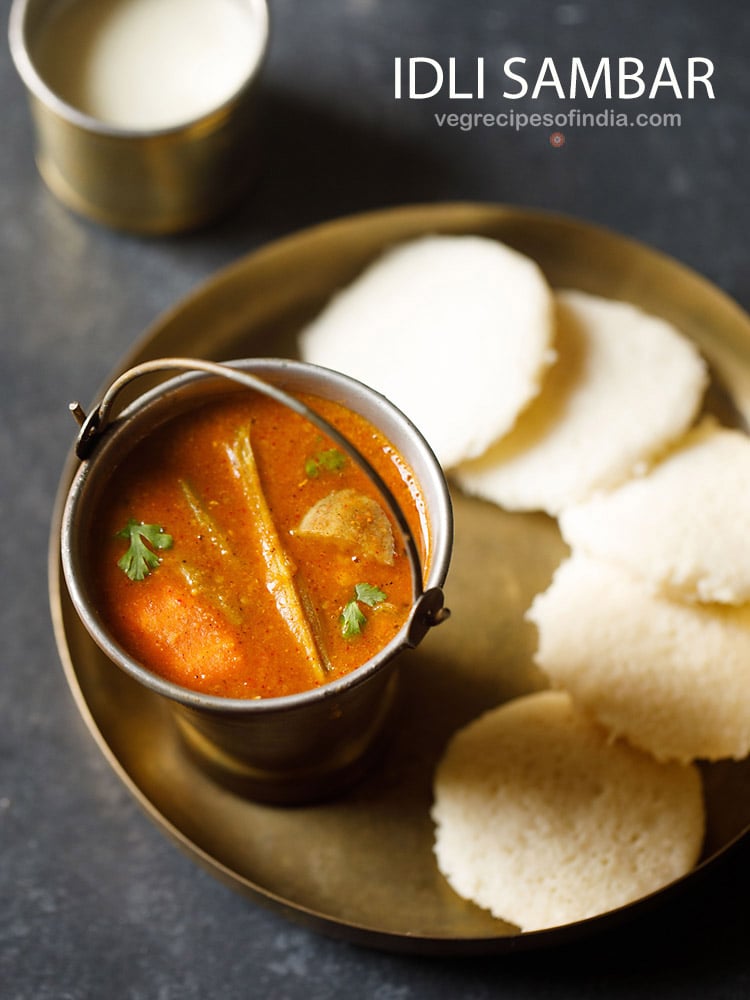
About Idli Sambar Recipe
In the South Indian cuisine there are many ways the sambar is made. I share one such variation which gives you a flavorful sambar like the one served in South Indian restaurants and hotels.
This idli sambar recipe is super tasty and can be served with South Indian tiffin snacks like idli, dosa, medu vada, rava idli, rava dosa, uttapam and pongal etc.
This is also one of the best tiffin sambar recipe. This hotel style sambar tasted damn good with soft and fluffy idlis. Oh yes, idli sambar and vada sambar are all time favorite at home. Not to forget our love for dosa too.
This recipe was shared by a reader friend Priya who writes to me often. She was gracious enough to share her sambar recipe as well as this recipe.
This recipe is adapted from Revathy Shanmugam’s recipe and Priya was kind enough to translate and send me the recipe. I had the good chance of having email conversation with her through a common friend and Revathy ji is a gracious and humble person.
I made some changes in the recipe to suit our taste buds. This dish was loved by the family and so they would ask me to make it again.
Even today I make this sambar to go with idli or medu vada. You can also enjoy this with steamed rice for a comforting meal.
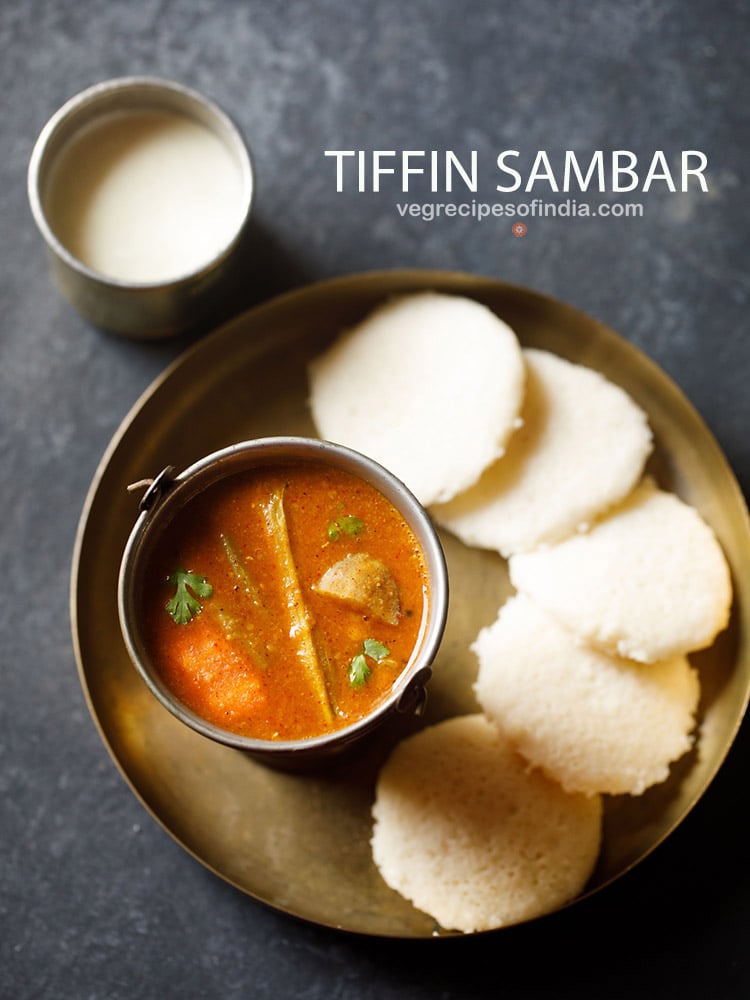
Planning & Cooking Tiffin Sambar
1. Some preparations and planning in advance are required if you want to make idli sambar for breakfast. So make the idli batter and ferment it in the previous afternoon or late evening (for winters) or night (for summers).
2. When the batter is fermented the next day, you can steam idli when you pressure cook the dal and cook the veggies in a pot or pan. I usually pressure cook lentils first. Then roast the spices and make the sambar powder from scratch.
When the lentils are cooking, I steam the idli and keep them stored in a casserole so that they stay warm. After making the tiffin sambar powder, I cook the veggies and then make the sambar.
3. On busy mornings, you can make the sambar powder a day before and refrigerate. Next day cook the lentils and veggies. Then make sambar.
4. For making idli sambar, you can either make small mini idli or the regular sized idli. Both taste good.
5. While serving idli sambar make sure the sambar is hot. The idli can be hot or warm. If the idli have turned cold, then sprinkle some water on them and warm them in a frying pan covered with a lid or in a microwave oven.
6. To make idli you can check my fail proof recipes
- Idli recipe – soft idli recipe
- Rava idli – quick and easy idli variety made with sooji or semolina
While serving idli sambar you can drizzle a bit of ghee on top. You can also top it with some chopped onions. Also garnish with some coriander leaves while serving.
How to make Idli Sambar
Cook Lentils
1. In a bowl take ¼ cup each of tuvar dal (arhar dal or pigeon pea lentils) and masoor dal (red lentils). You can also just take overall ½ cup of tuvar dal.
As you see in the photo below pigeon pea lentils are yellow colored and they are split and without husk. The red lentils or orange colored lentils are also husked and split.
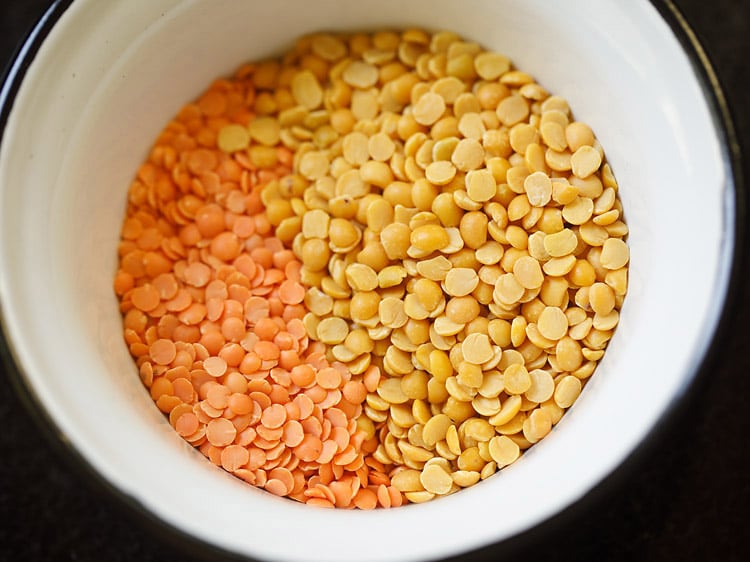
2. Rinse the lentils well in fresh water and then add them in a 2 litre pressure cooker.
You can also cook these lentils on stove top in pan or in an instant pot. If cooking in a pan, I suggest to soak the lentils in enough water for at least half an hour so that they cook faster.
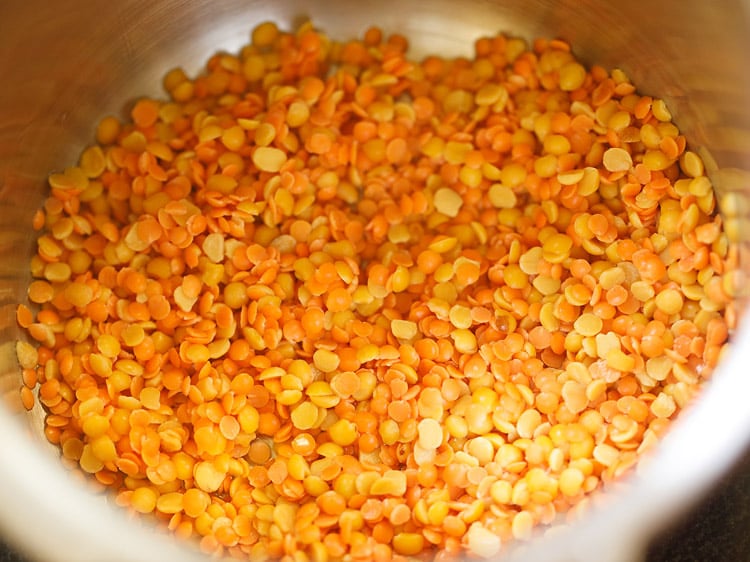
3. Add ¼ tsp turmeric powder and 1.25 to 1.5 cups of water in the pressure cooker.
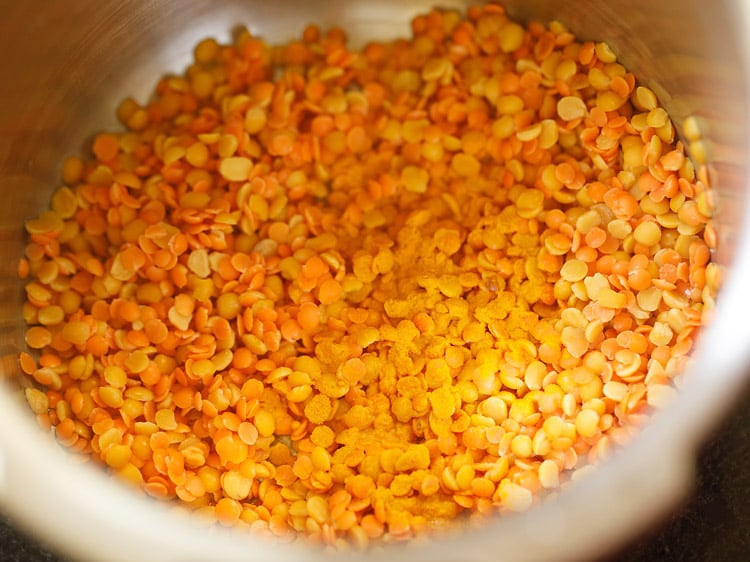
4. Pressure cook the lentils till they are soft, mushy and well cooked for about 7 to 8 whistles or 11 to 12 minutes on a medium flame.
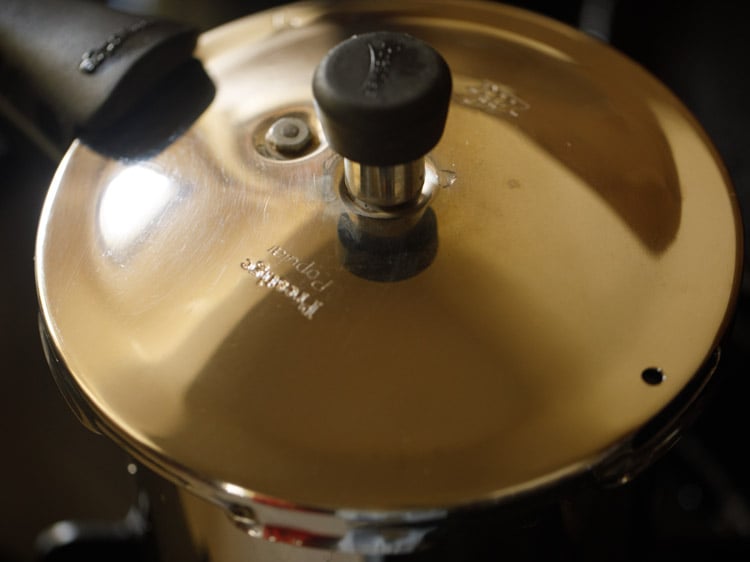
5. Open the lid once the pressure settles down naturally in the cooker. The lentils should have softened very well, so that they can be easily mashed.
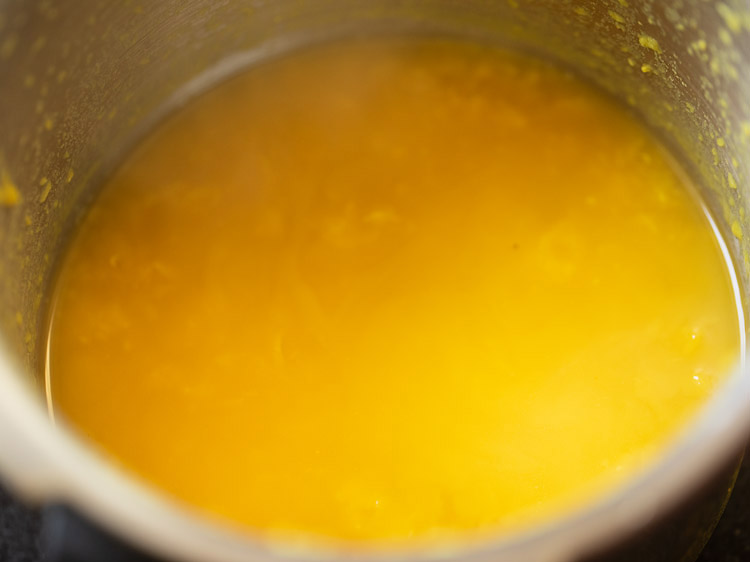
6. Mash the lentils with a spoon or wired whisk and set aside.
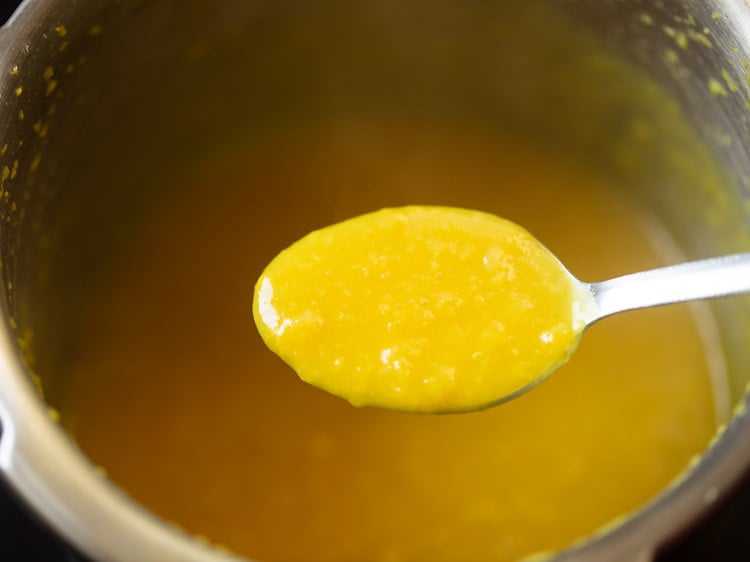
Make Tamarind Pulp
7. Take 1 tablespoon tamarind and soak it in ¼ to ⅓ hot or warm water for 20 to 30 minutes.
Tip: If you don’t have dried tamarind then you can use about ½ tablespoons of packaged tamarind paste or as needed.
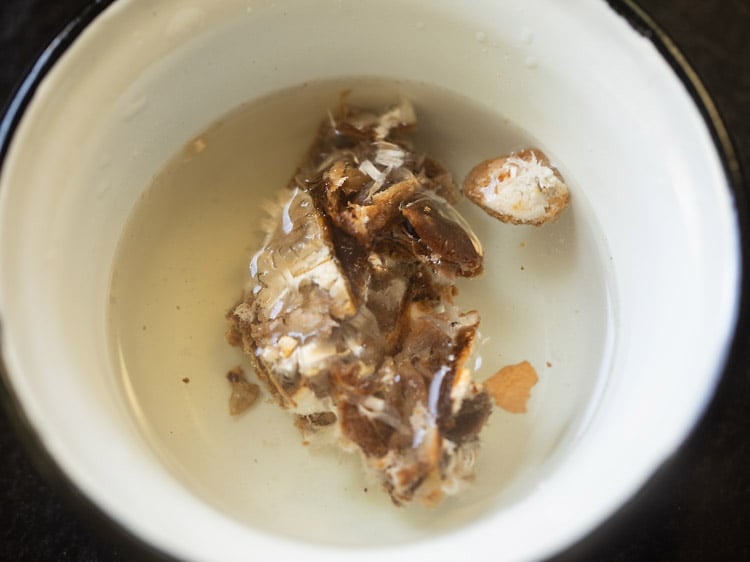
8. Later squeeze the tamarind in the water and you get the tamarind pulp. You can even strain tamarind pulp and keep aside.
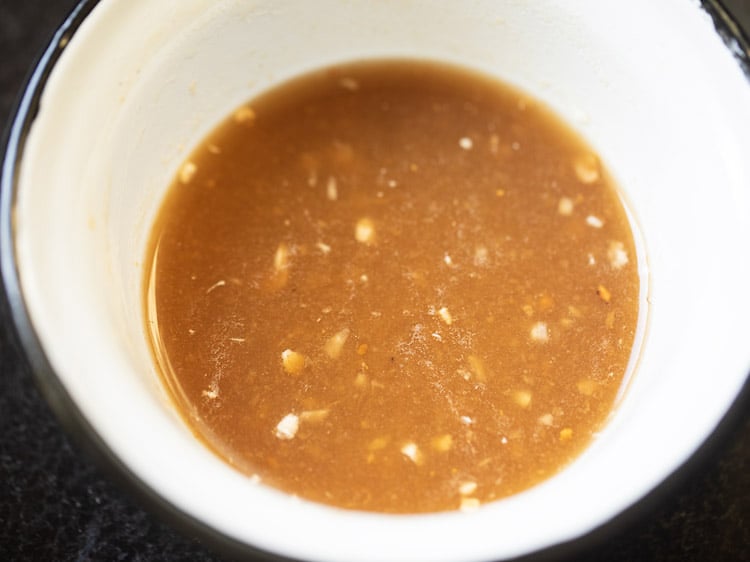
Make Sambar Spice Mix
9. In a heavy small frying pan, heat 2 teaspoons oil. Keep the flame to its lowest. First add mustard seeds. Mix and stir.
You can use any neutral flavored oil.
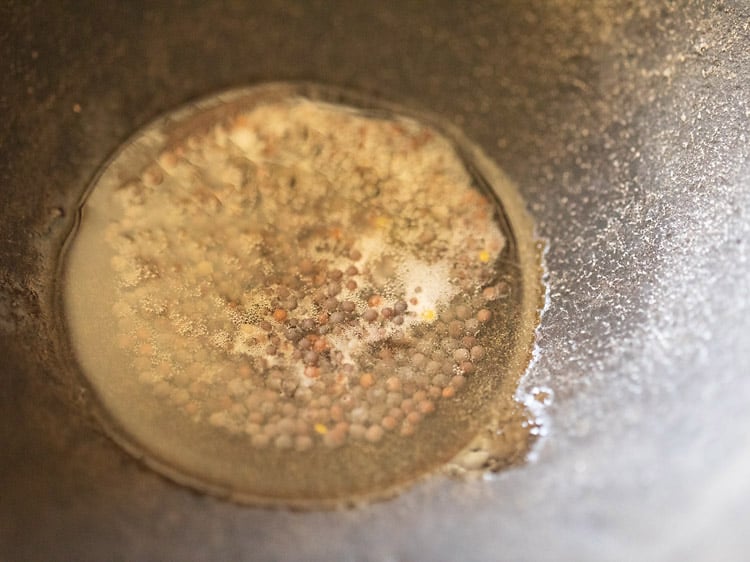
10. Then add the remaining whole spices – coriander seeds, fenugreek seeds, cumin seeds, black pepper, chana dal (husked and split bengal gram). Mix and stir.
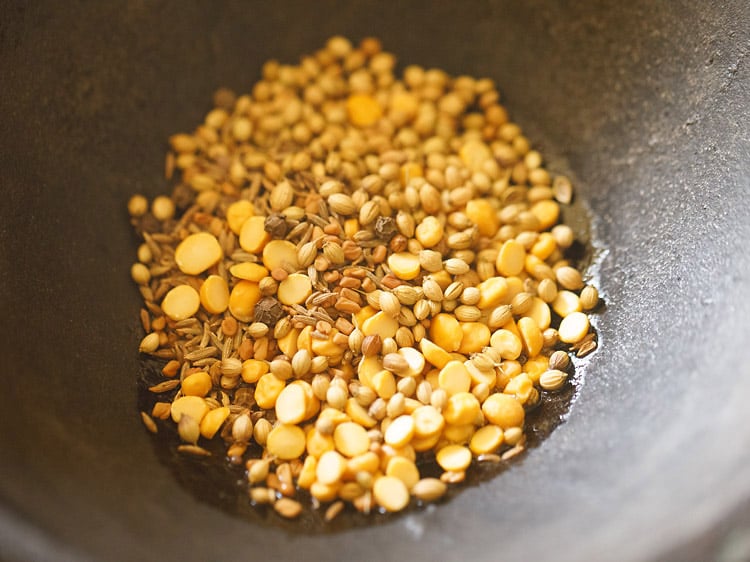
11. Immediately add 5 Kashmiri red chillies or 5 byadagi chilies (broken and seeds removed).
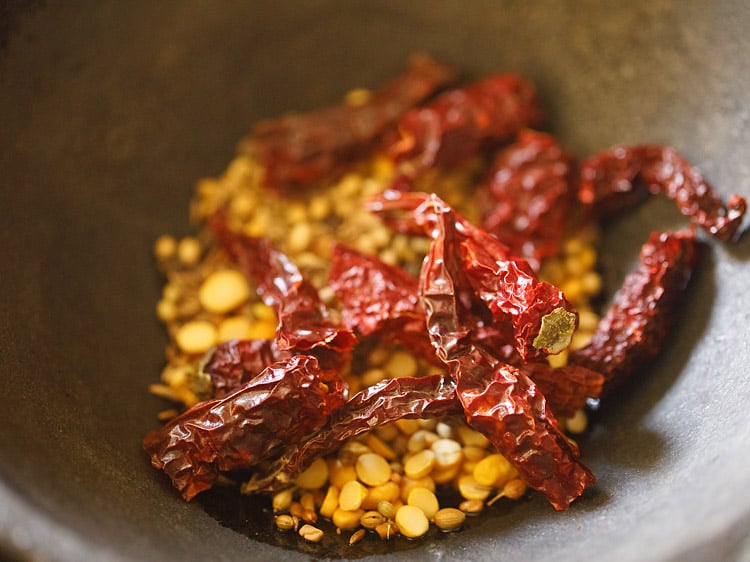
12. Next add curry leaves.
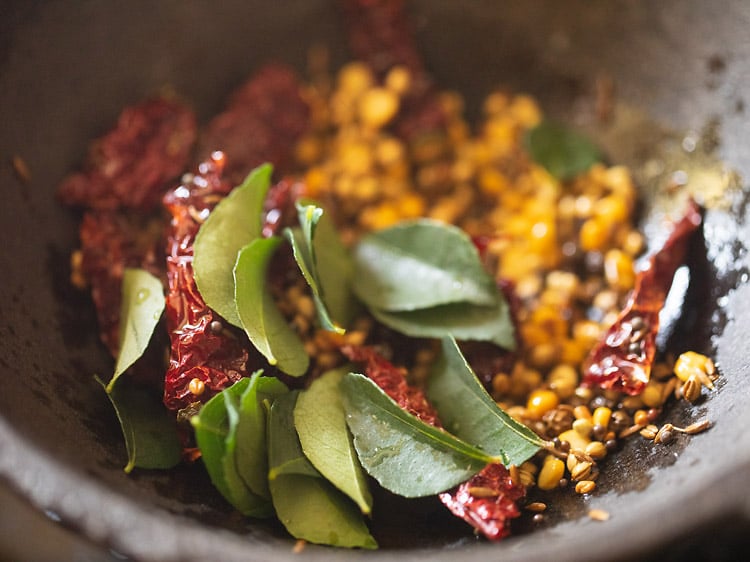
13. Mix very well. On a low heat, stir non-stop and roast till the spices become aromatic. Your kitchen will smell fragrant while roasting these spices. Ensure that you don’t burn the spices.
Once the spices are roasted well, you can also add 2 to 3 tablespoons fresh coconut or desiccated coconut. Mix the coconut and roast for 1 to 2 minutes and switch off the flame.
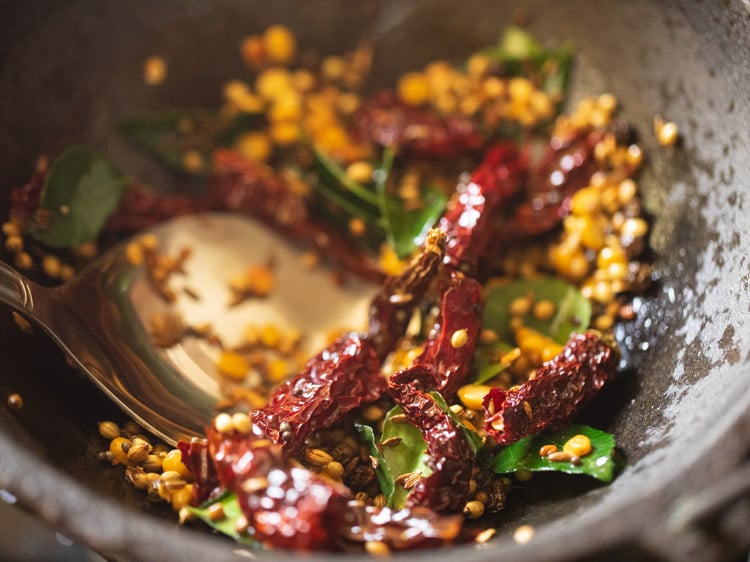
14. Keep aside to cool.
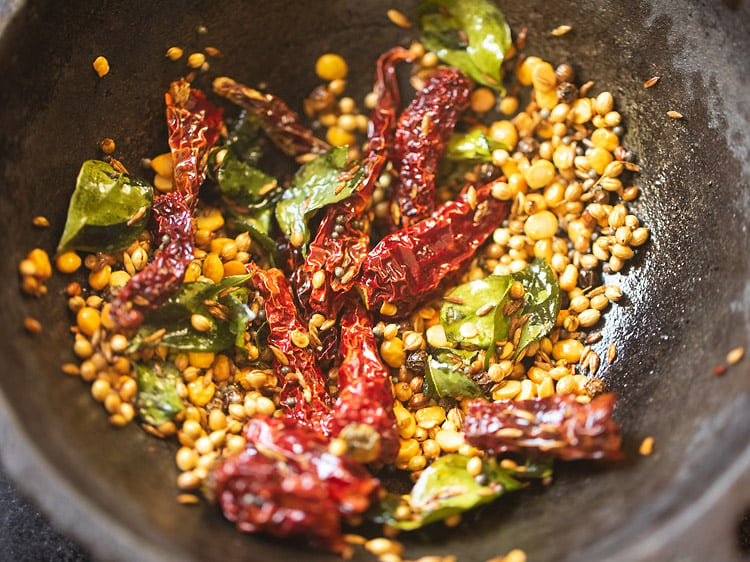
15. Once the spices cool, grind them to a fine powder in a dry grinder or coffee grinder.
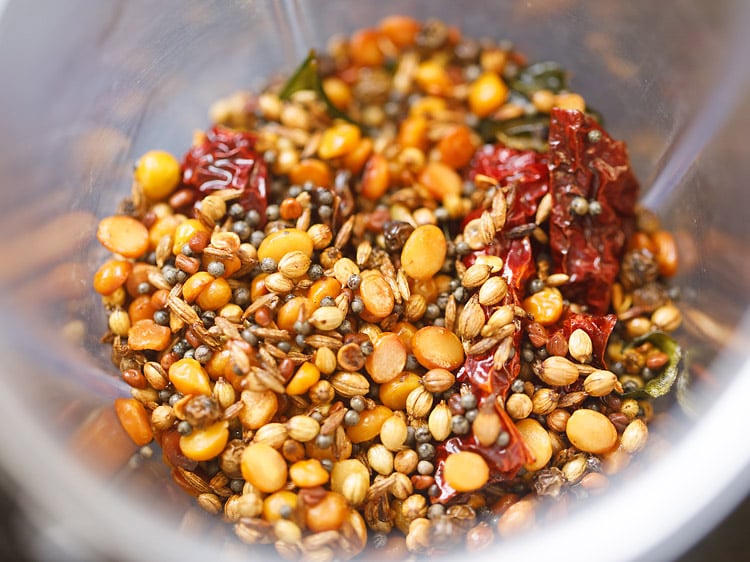
16. Keep the tiffin sambar powder or spice mix aside.
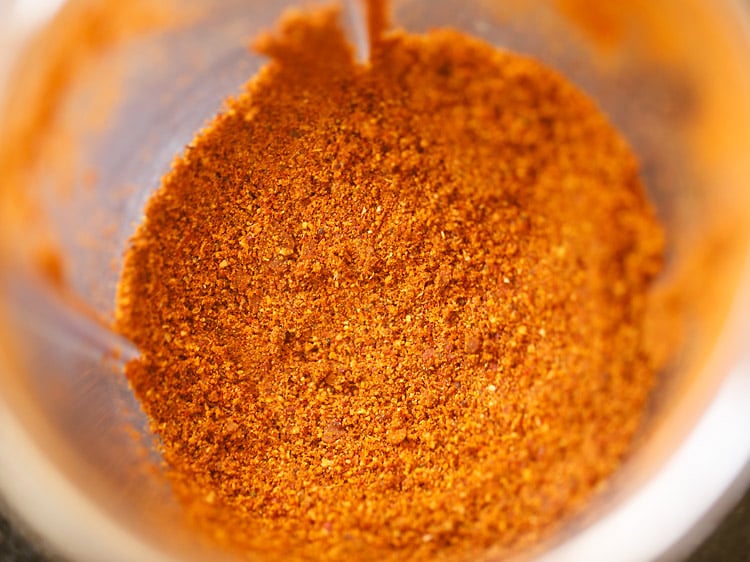
Make Idli Sambar
17. Rinse and peel the veggies. Chop them and keep aside. You can use a mix of drumsticks, carrots, pearl onions, yellow pumpkin, radish, green beans, ash gourd, potatoes, brinjal (eggplant), okra etc.
While cooking just remember to add the veggies that take more time to cook first and later add the veggies which take less time to cook.
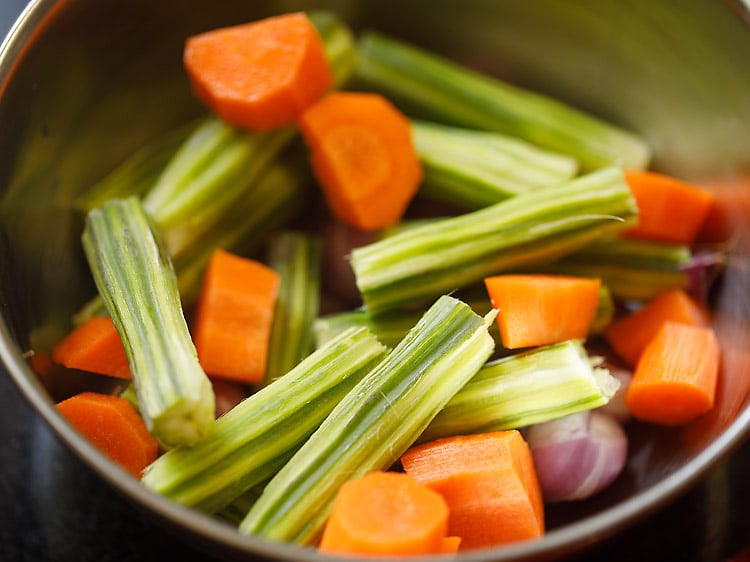
18. For brinjals, chop them and add them to water so that no discoloration occurs.
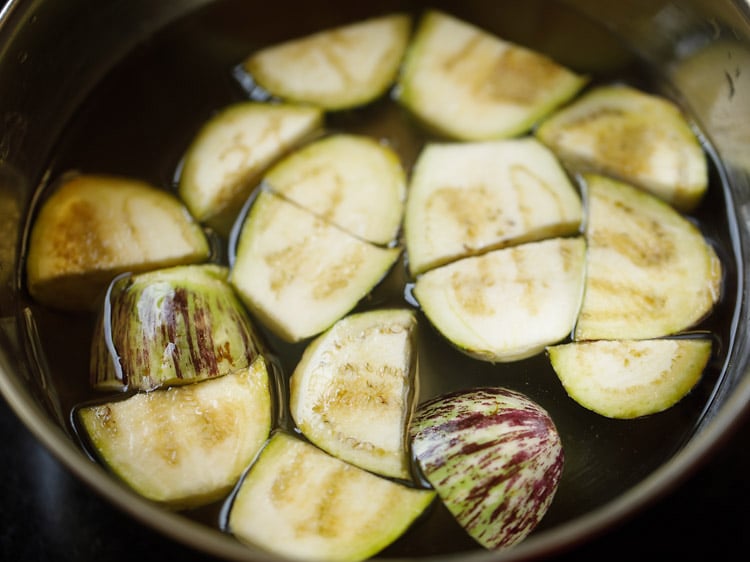
19. In a pot, heat 2 tablespoons oil first. Keep flame to a low or medium-low flame. Add the mustard seeds and let them crackle.
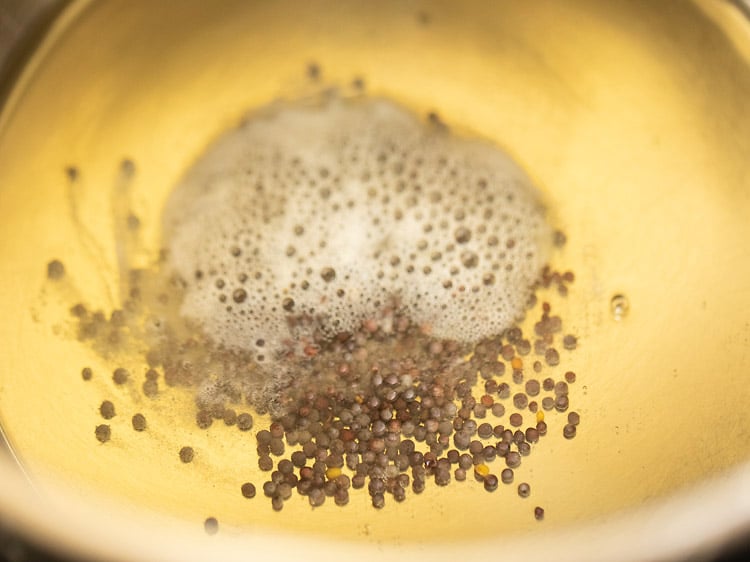
20. Then add the urad dal (husked and split black gram).
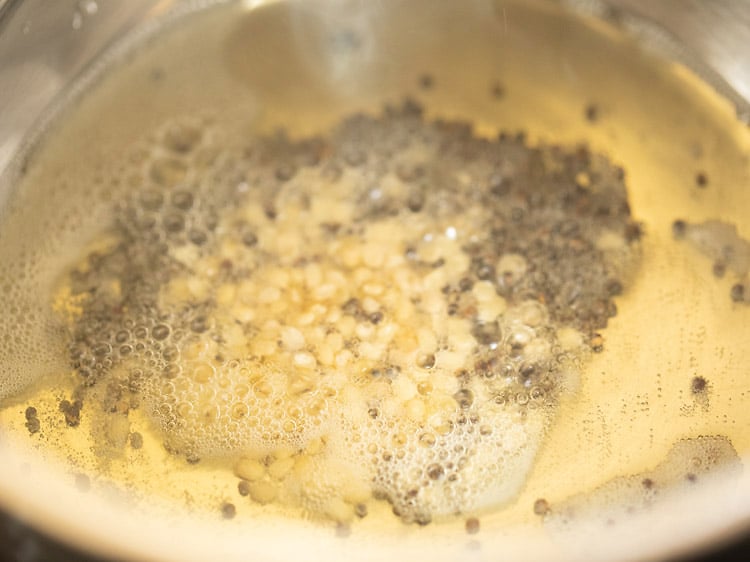
21. Let the urad dal turn into a maroonish color.
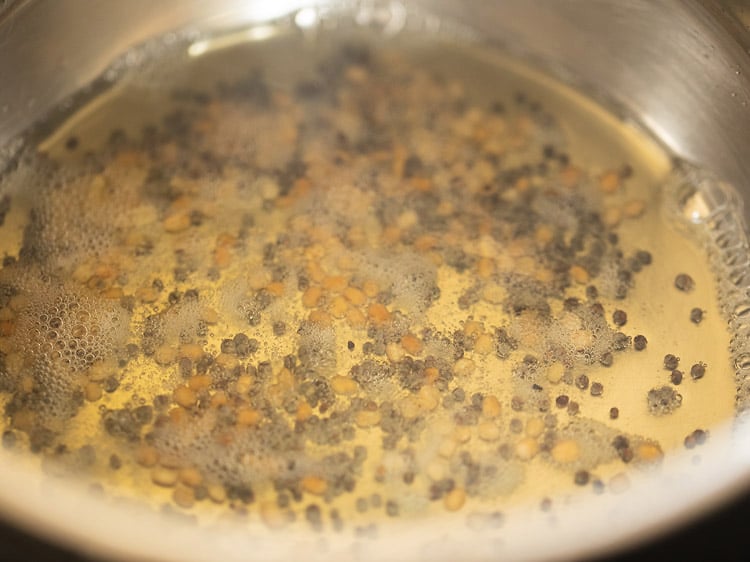
22. Then add quartered onions or pearl onions (whole or halved), curry leaves and asafoetida (hing).
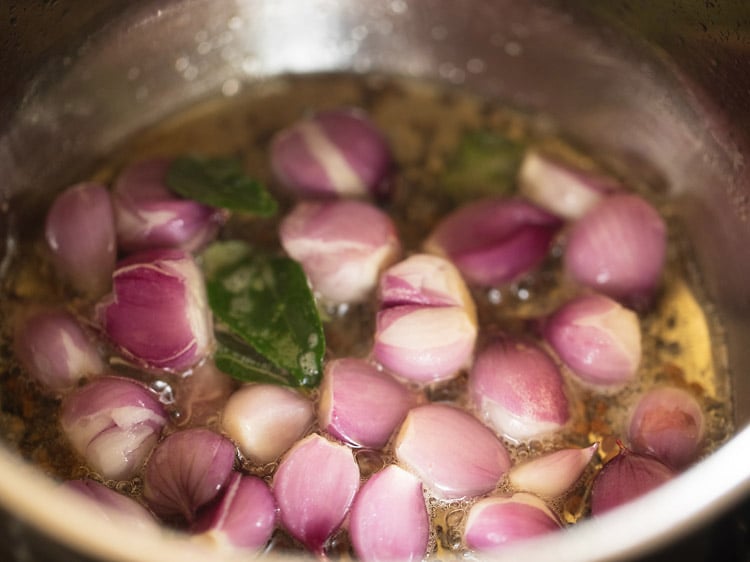
22. Stir and saute for 2 minutes on a medium-low flame.
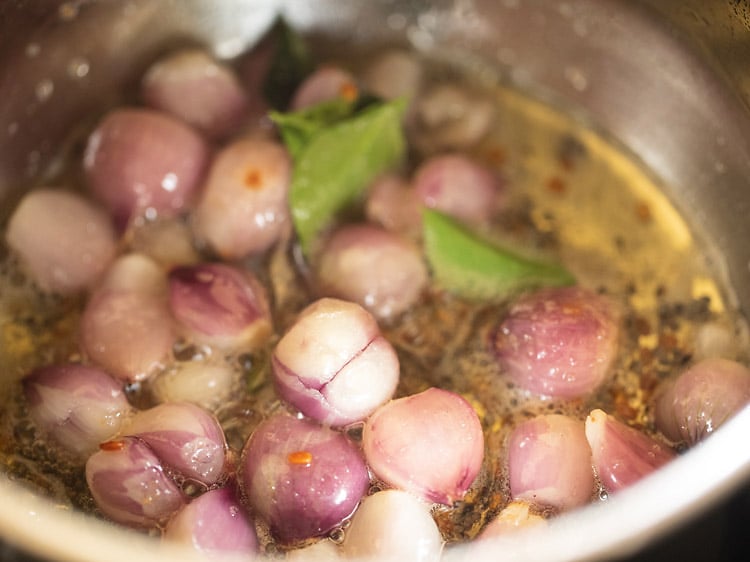
23. Saute till the onions soften a bit.
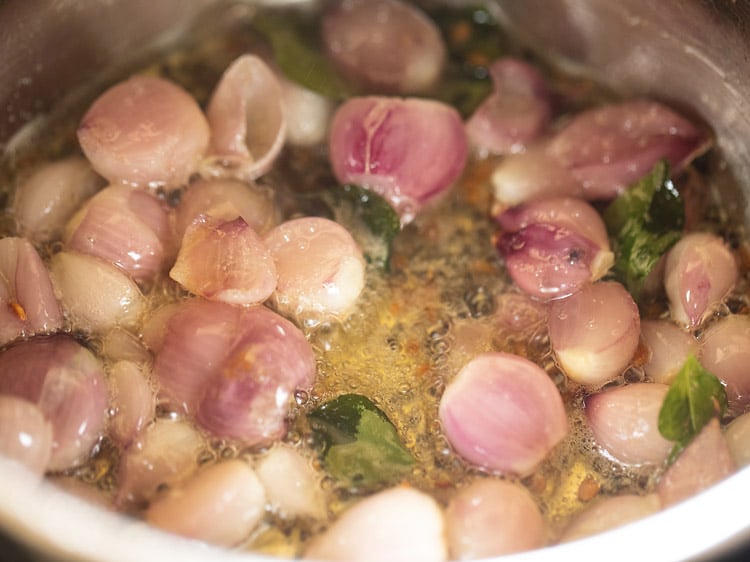
24. Then add the chopped tomatoes.
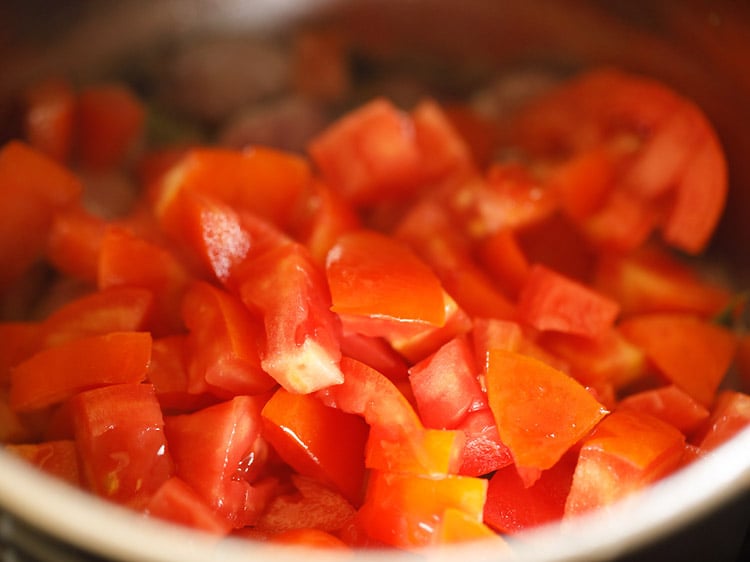
25. Saute tomatoes for 4 to 5 minutes on a medium-low flame.
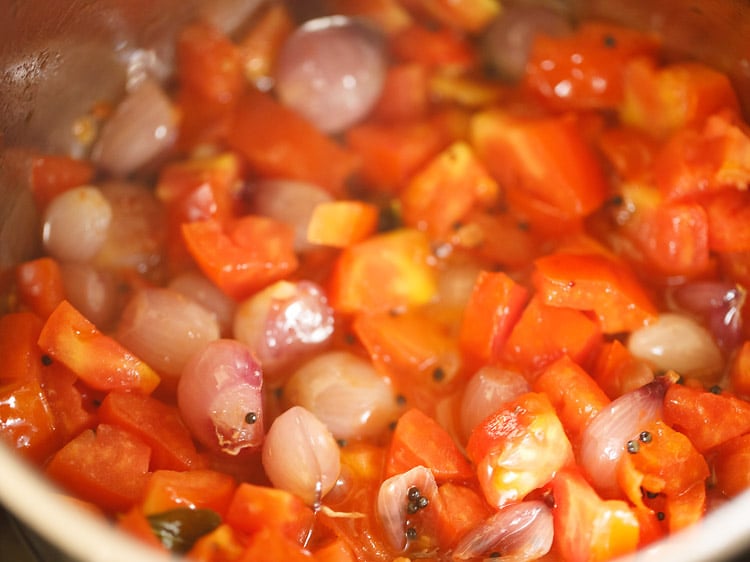
26. Next add veggies which take more time to cook like carrots, beans, potatoes, drumsticks etc.
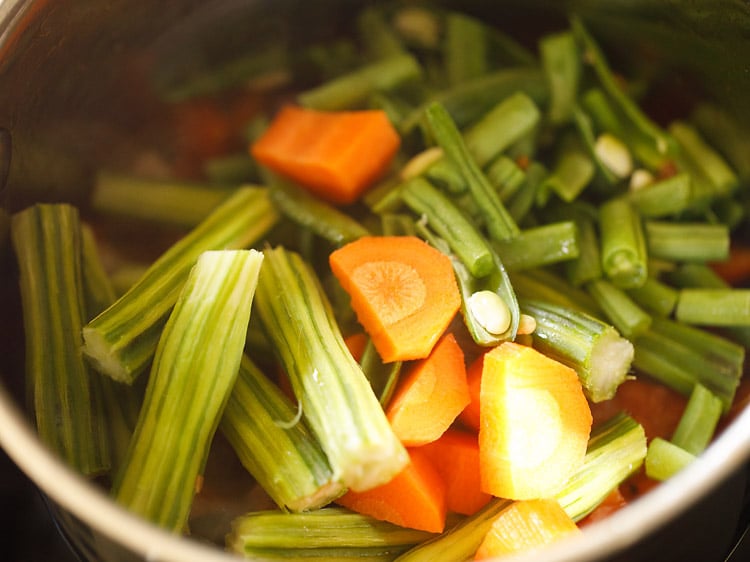
27. Sauté for 4 to 5 minutes on medium-low flame stirring often.
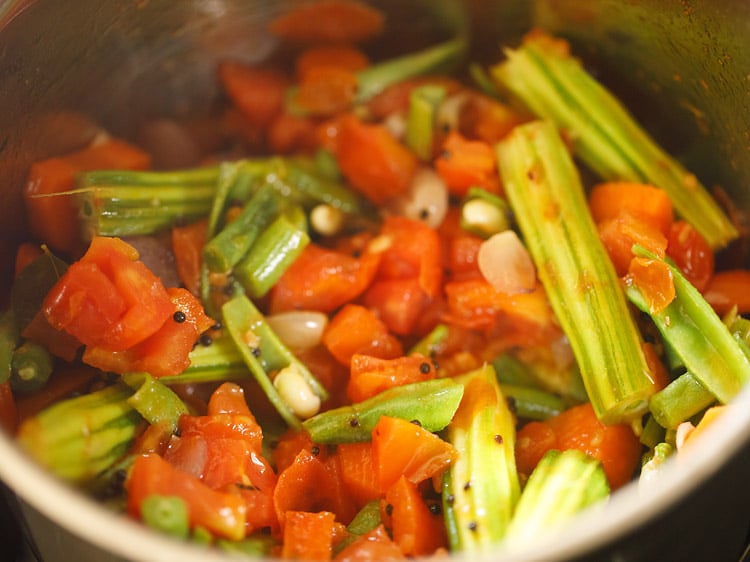
28. Then add remaining quick-cooking veggies like brinjals, ladyfingers (okra), pumpkin etc now. Mix well.
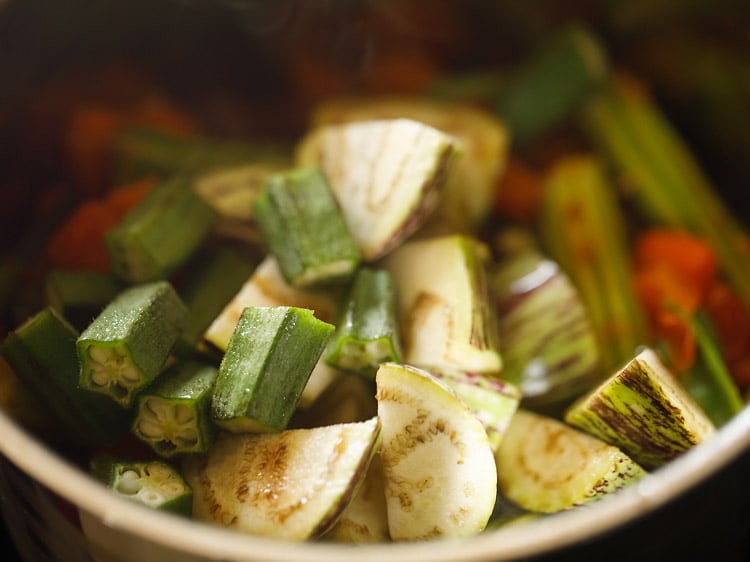
29. Add the prepared tamarind pulp.
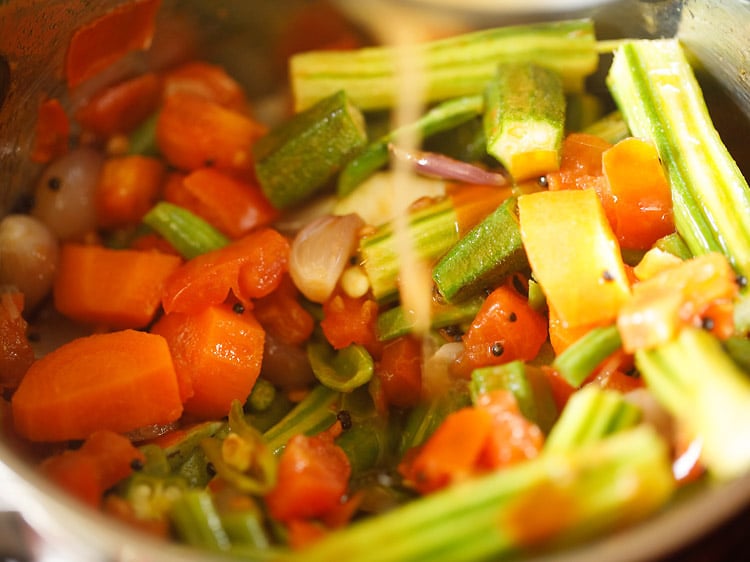
30. Pour water.
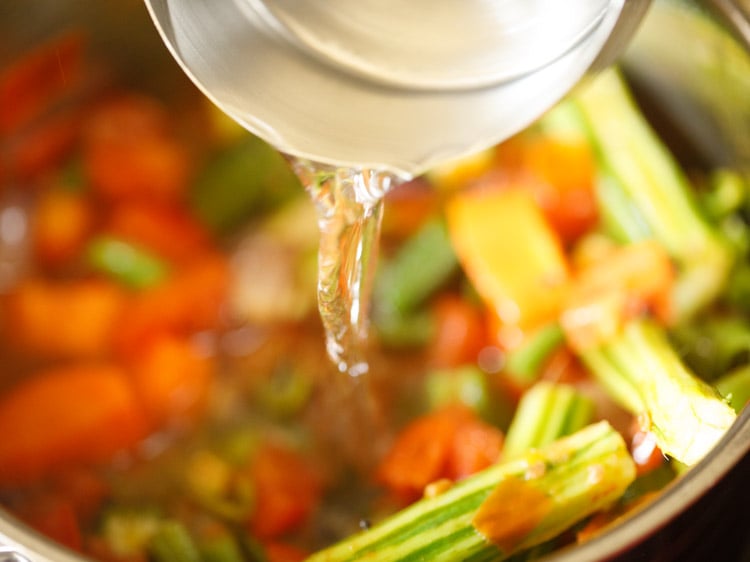
31. Add salt as per taste and mix well.
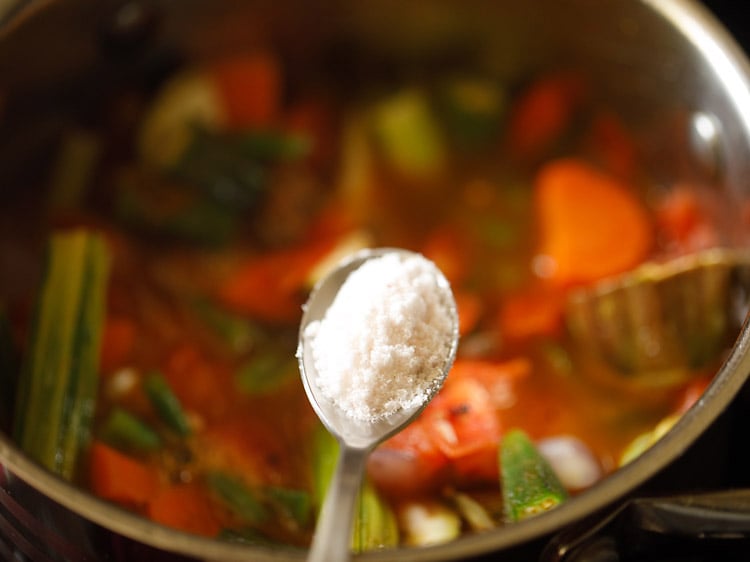
32. Cover the pan and simmer on a medium-low flame until the raw aroma of the tamarind goes away and the veggies are almost cooked. If they are undercooked, then continue to simmer till they soften.
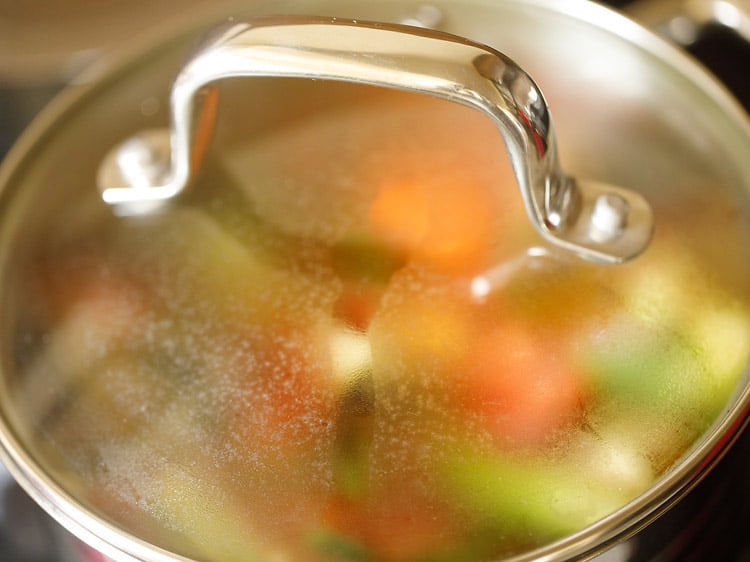
33. The veggies should be almost cooked before you proceed to another step.
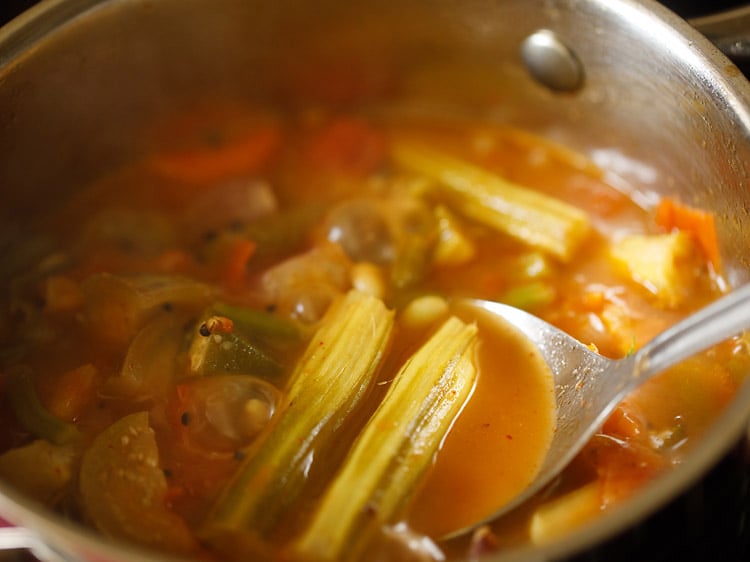
34. Add the ground sambar masala powder which we have already prepared earlier.
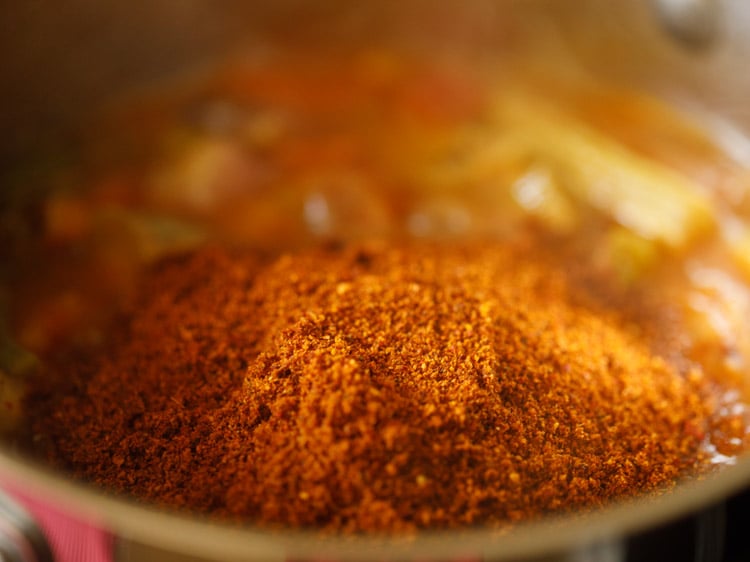
35. Mix very well.
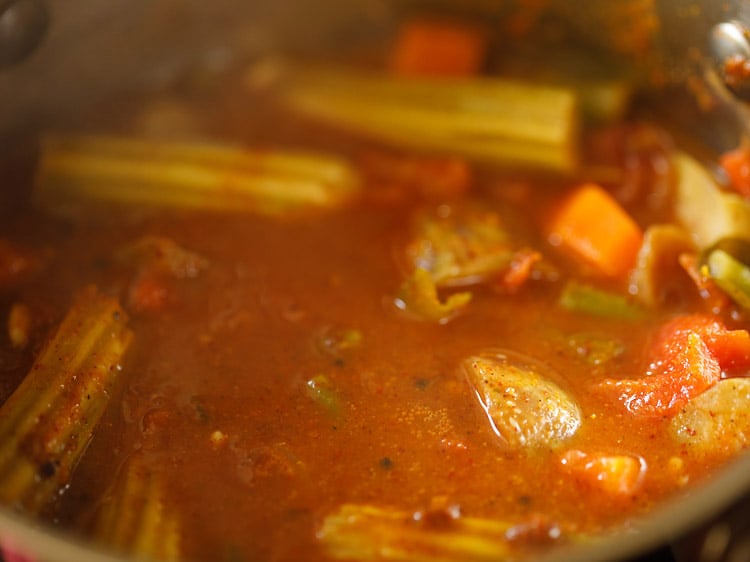
36. Add the mashed dal.
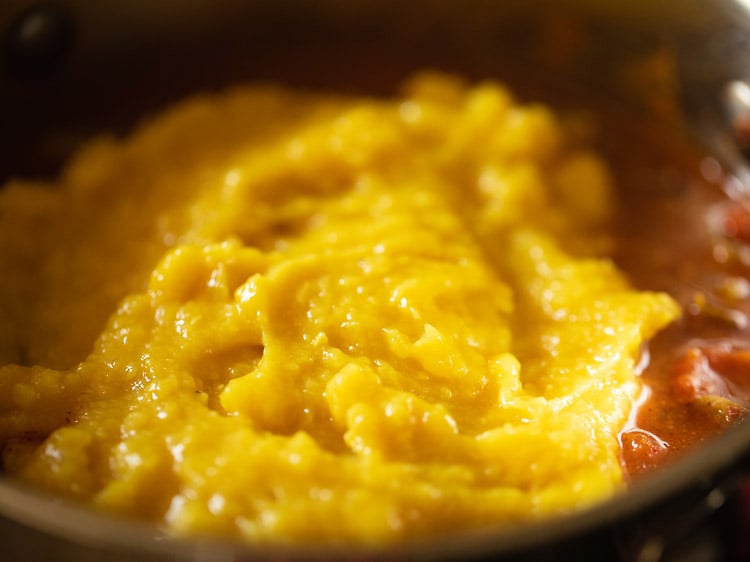
37. Mix again very well. Also add 1 cup water or more to get the consistency you want.
The tiffin sambar served in the hotels is usually thinner. For idli, dosa and medu vada you can keep the sambar having a medium to thin consistency. For serving with rice, keep the tiffin sambar slightly thick.
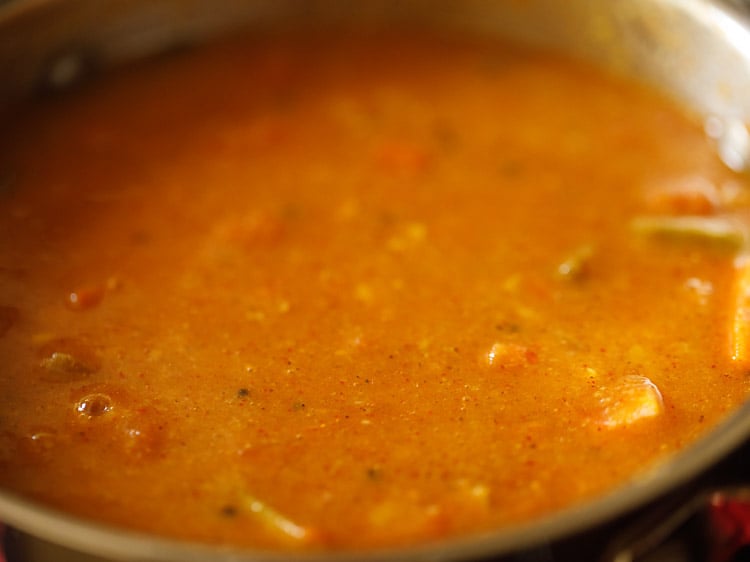
37. Stir and simmer without lid for about 6 to 7 minutes or till it comes to a boil. Then switch off the flame. Stir at intervals so that the lentils do not stick at the bottom of pan.
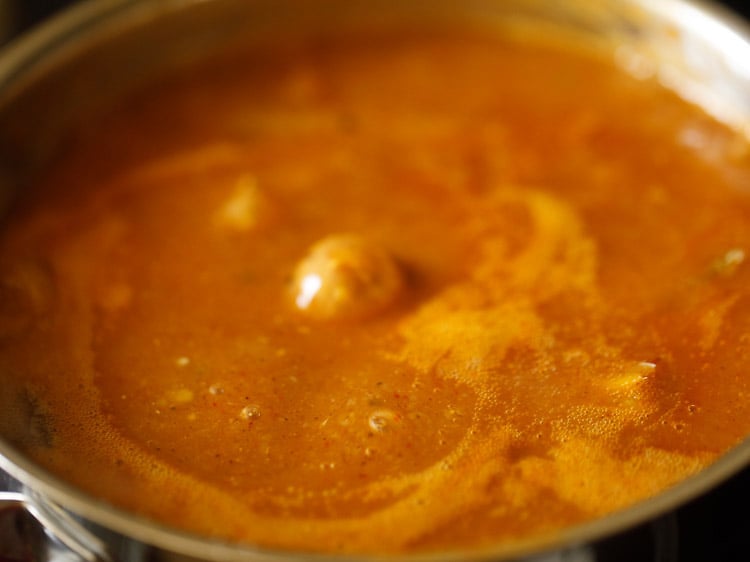
38. Meanwhile when you keep the dal for pressure cooking, you can steam idli. Both small-sized mini idli or large idli goes well with this tiffin sambar.
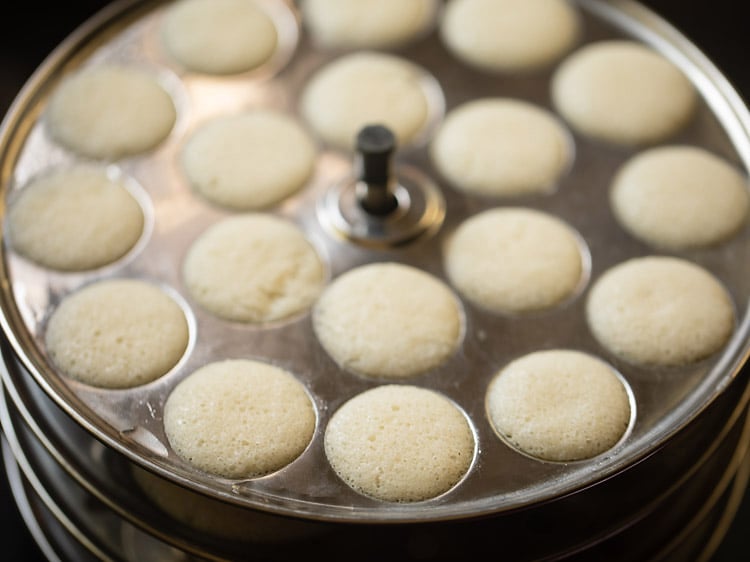
39. While serving place the idli in a serving bowl. Pour sambar. Garnish with some coriander leaves. You can even drizzle a bit of ghee on top. Serve idli sambar hot.
This tiffin sambar can also be served hot with idli, medu vada, uttapam or masala dosa. You can also enjoy with steamed rice.
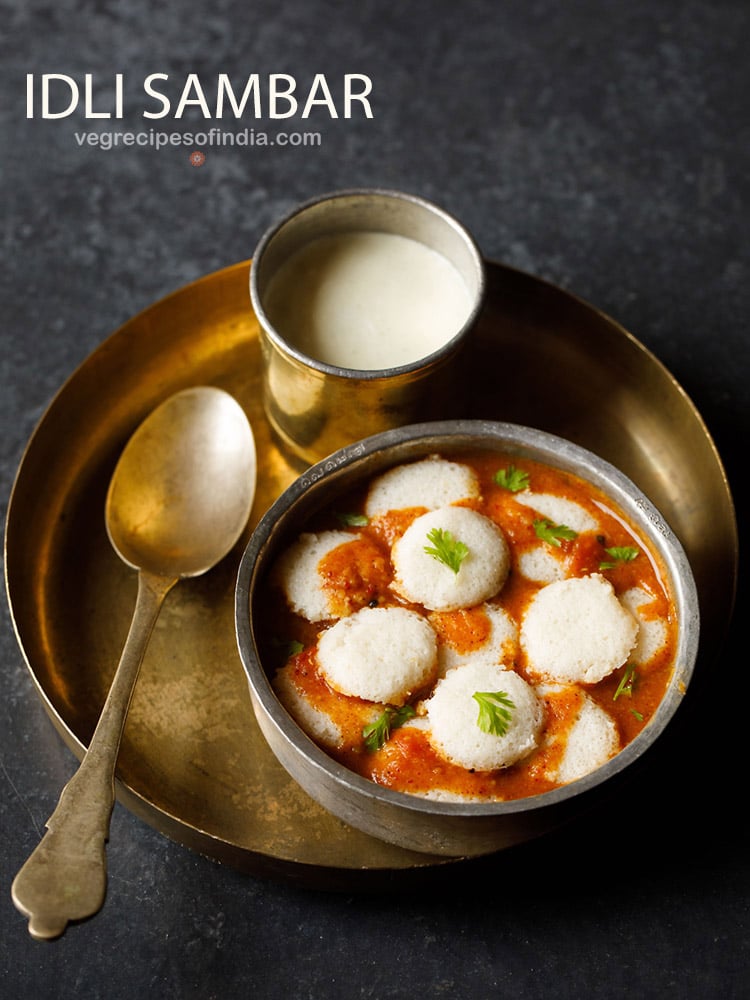
Expert Tips
1. In the recipe freshly roasted and ground sambar powder is made. This ground sambar powder adds a lot of flavor and taste in the sambar. If you are short of time, then you can use any sambar powder you have and make this recipe. I also make a simple and quick sambar recipe where I add homemade sambar powder. Do note that the final taste of the sambar depends a lot on the type of sambar powder added. So use a good quality sambar powder or use your homemade sambar powder.
2. While roasting the spices for the sambar powder, roast in a heavy pan or a thick bottomed pan on a low flame. Stir non-stop so that the spices do not get burnt. The spices have to be roasted till they become aromatic and golden. Use fresh spices and make sure that they are not rancid.
3. Tomato is one of the key ingredient in this sambar and they add a lot of flavor to the sambar. So please do not skip adding tomatoes. For the veggies, add the ones that are usually added in sambar. Do try to add drumsticks if you can as in most hotel style sambar, drumsticks are added and they give a nice taste & flavor in the sambar. You can also add carrots, green beans, flat beans, ladyfingers (okra), brinjals, potatoes, pumpkin, ash gourd, onions etc.
4. Both tuvar dal and masoor dal are added in the sambar served in hotels. If you do not have masoor dal, you just add tuvar dal. You can also add some moong dal in combination with tuvar dal and masoor dal.
5. Tiffin sambar is usually served with the tiffin snacks – idli, dosa or medu vada. but you can also serve this sambar with steamed rice. Do give this recipe a try next time you make idli, dosa or medu vada or even steamed rice.
More sambar variations
Please be sure to rate the recipe in the recipe card or leave a comment below if you have made it. For more vegetarian inspirations, Sign Up for my emails or follow me on Instagram, Youtube, Facebook, Pinterest or Twitter.
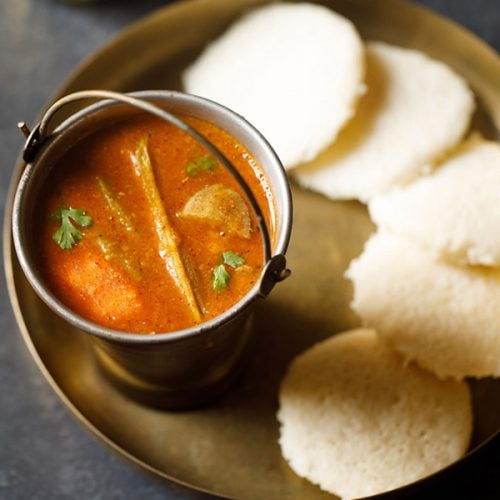
Idli Sambar Recipe (Hotel Style Tiffin Sambar)
Ingredients
For cooking lentils
- ¼ cup arhar dal (husked and split tuvar dal or pigeon pea lentils)
- ¼ cup masoor dal (husked and split red lentils)
- ¼ teaspoon turmeric powder (ground turmeric)
- 1.25 to 1.5 cups water for pressure cooking – for a 2 litre cooker
For tempering
- 2 tablespoons oil (gingelly oil, sunflower oil or peanut oil)
- ½ teaspoon mustard seeds
- 1 teaspoon urad dal (husked and split black lentil)
- 4 to 5 curry leaves
- ¼ teaspoon asafoetida powder (hing)
For cooking veggies
- 1 large onion or 10 to 12 pearl onions or shallots or 90 to 100 grams onions
- 3 medium tomatoes or 220 to 230 grams tomatoes
- 1 to 2 drumsticks – scraped and chopped in 2 to 3 inch pieces
- 1 medium carrot
- 6 to 7 green beans or flat beans – chopped
- 1 medium potato – optional
- 4 to 5 okra – chopped
- 6 to 7 small brinjals (baingan or eggplant) or 80 to 100 grams
- 1 to 1.25 cups water or add as required
- salt as required
For tamarind pulp
- 1 tablespoon tamarind
- ¼ to ⅓ cup warm or hot water
For sambar powder
- 5 kashmiri chilies or byadagi/bedgi chilies or 4 to 5 dry red chilies – reduce depending upon the heat in the chilies
- 11 to 12 large curry leaves or 16 to 18 small curry leaves
- 1.5 tablespoons coriander seeds
- 1 tablespoon chana dal (split and husked bengal gram)
- 1 teaspoon cumin seeds
- ½ teaspoon mustard seeds
- ½ teaspoon whole black pepper
- ¼ teaspoon fenugreek seeds (methi dana)
- 2 teaspoons oil (gingelly oil, sunflower oil or peanut oil)
Other ingredients
- 1 cup water to be added later or add as required
- few coriander leaves for garnish
Instructions
Cooking the lentils
- Rinse both the lentils well and then add them in a 2 litre pressure cooker with 1.25 to 1.5 cups water and ¼ tsp turmeric powder.
- Pressure cook the lentils for 7 to 8 whistles or 11 to 12 minutes until the lentils have softened and well cooked.
- You can also cook the lentils in a pan on a stove top or in the instant pot. I recommend to soak the lentils for about 30 minutes in enough water prior to cooking them in a pan. This helps in the faster cooking of the lentils.
- Once the pressure settles down naturally in the cooker, open the cooker. Mash the lentils with a wired whisk and spoon. Keep aside.
Making sambar powder
- In a small and heavy frying pan, heat 2 teaspoons oil. Keep the flame to a low. First, add the mustard seeds.
- Then add the coriander seeds, cumin seeds, black pepper, chana dal (bengal gram), fenugreek seeds, curry leaves and dry red chillies.
- On a low flame stir non-stop and roast till the spices become aromatic and golden.
- Keep aside to cool. Don’t burn the spices.
- Once the spices cool, grind them to a powder in a dry grinder or coffee grinder. Keep aside.
Preparation for idli sambar
- Soak the tamarind in warm water for 25 to 30 mins.
- Later squeeze the tamarind in the soaked water and extract the tamarind pulp. You can strain tamarind pulp and keep aside.
- Chop all the veggies. Quarter the onions or halve the pearl onions. Peel and dice the carrots and potatoes.
- Dice the brinjals and add them in water to prevent discoloration.
- Chop the tomatoes in small pieces.
Cooking veggies
- In a pan, heat oil first. Add the mustard seeds and let them begin to crackle. Then add the urad dal and sauté till they turn to a maroonish color.
- Add quartered onions or halved pearl onions, curry leaves and asafoetida. Stir and saute for 2 minutes till the onions soften a bit.
- Add the tomatoes, salt as required and continue to saute for 4 to 5 minutes on a medium-low flame.
- Then add the veggies which take a longer time to cook (carrots, beans, potatoes, drumsticks etc) and saute for 4 to 5 minutes on a medium-low flame.
- Then add remaining quick-cooking veggies like brinjals, ladyfingers (okra), pumpkin etc now. Stir and mix.
- Add the tamarind pulp and 1 to 1.25 cups water.
- Season with salt as per taste. Mix well.
- Cover pan and simmer until the raw aroma of the tamarind goes away and the veggies are almost cooked.
- If the veggies are undercooked, then continue to simmer till they are almost cooked.
Making idli sambar
- Add the ground sambar powder which we have already prepared. Mix well.
- Add the mashed dal.
- Add 1 cup water or as required depending on the consistency you want. The sambar which is served in the hotels is on the thinner side. For idli, dosa and medu vada you can keep the sambar having a medium to thin consistency. For serving with rice, keep the tiffin sambar slightly thick.
- Stir and simmer without lid for about 6 to 7 minutes or till it comes to a boil. Stir at intervals.
- Check the taste and add more salt if required.
- Meanwhile when you keep the dal for pressure cooking, you can steam idli. Both small-sized mini idli or large idli goes well with tiffin sambar.
- While serving place the idli in a serving bowl. Pour sambar. Garnish with some coriander leaves. You can even drizzle a bit of ghee on top. Serve idli sambar hot.
- You can also garnish with coriander leaves and serve hot with medu vada, idli, dosa, uttapam or even with steamed rice.
Video
Notes
- You can add your choice of veggies.
- This recipe can be halved or doubled too.
- Instead of tuvar dal (pigeon pea lentils), you can also use a combination of tuvar dal and masoor dal (pink lentils). Even moong dal can be used.
Nutrition Info (Approximate Values)
This Idli Sambar Recipe from the blog archives was first published on May 2014. It has been updated on December 2024.



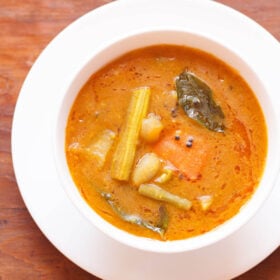









Recipes are very nice, recipe with step by step along with picture of recipe is very good to understand the method of the particular recipe, thankyou
welcome anunitha. thanks for sharing positive feedback.
thanks for this recipe, sambar tasted very awesome, me and my elder sister love it.
welcome siciliya. glad to know this.
had made sambhar before but it never tasted so good. i added a few more vegetables and followed the steps exactly…..hmmmm very tasty. thanks
welcome jitu. glad to know this.
Hi Dassana
i made this for lunch today and it turned awesome.thanks for the beautiful recipe. Can u post koli masala ingredients. I have heard its very tasty bt u dnt get it at calcutta.
thanks sunita
thanks and welcome sunita. i know of of a food blogger who prepare koli masala and delivers it. i have not used it, as i do not make sea food. but a few blogger acquaintances have given good reviews. you can check the link here – http://www.annaparabrahma.com/Koli-Style/Koli-Masala-250gms-id-862875.html
Hi Dassana,
Wanted to know that while grinding the sambhar masala, should the curry leaves be ground or should I discard them after tempering?
Awaiting a reply soon.
kunj, you have to ground the curry leaves.
Your recipe is good mam. But I have one doubt, we South Indians generally wont grind the mustard seeds. If we do so, they’l say that it will change the taste. Can we do so?
thanks dharani. if you want then skip grinding the mustard seeds. this is a south indian recipe only. there are many ways of making a recipe. thats why the difference.
awesome sambhar …siimply mouth watering. … previously I was using achi sambhar powder but after making this shifted to yours recipes .. I just wanna ask can I keep this masala in air tight container and how long ??
thanks meeta for sharing positive feedback on sambar. glad to know this. you can store it for more than a month.
Hey Dassana.. Can i use Badshah Sambhar Masala instead?
sneh, you can use but taste will be different. i suggest to follow this recipe.
Thanks for the recipe….i followed the same procedure as you mentioned result was a tastey sambar.
welcome manjushree.
It is an awesome recipe. Got a lot of compliments when guests had it. Five Stars.
thanks suresh
Great recipe! I had a coffee grinder handy and was able to make the masala from scratch……I just added my own twist of a crushed garlic clove and one green chilli……..but overall best sambar I had in over a year 🙂
thanks ankita for sharing your positive feedback on tiffin sambar. good to know your variation.
Excellent demo. Thanks.
welcome krishna
Can I use dry curry leaves in any part of this recipe? Or only fresh? Thanks!
you can use dry curry leaves to make the sambar powder as well as while tempering.
Hi
Your way of expressing clear instructions with pictures is of great help. I am an occasional writer but a regular cook at home. I have found many recipes from your food blog that have turned out quite well.
Thanks
Reshma krishnamurthy
welcome reshma. thanks for sharing positive feedback on recipes.
Awesome. Truly authentic hotel sambar taste!
thanks rajesh for sharing positive feedback.